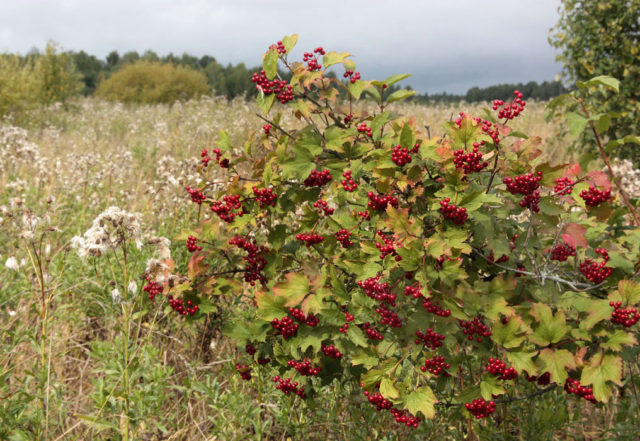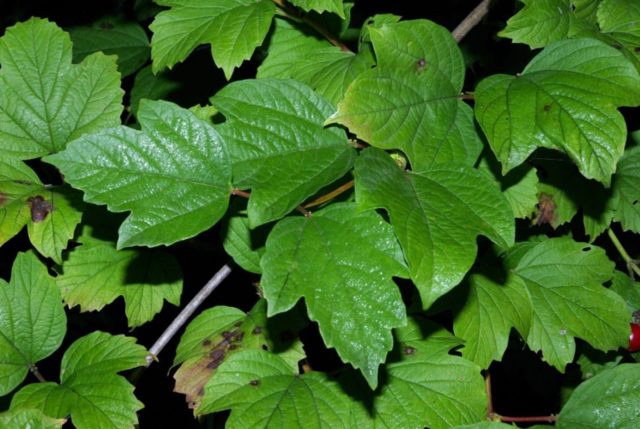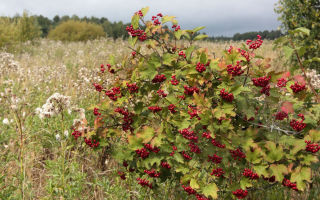Content
Viburnum berries are appreciated for their taste and unique composition. In Russia, the bunches were placed in a house in a conspicuous place as a talisman against the evil eye. The plant has been widely used since ancient times. Berries are recommended for the treatment and prevention of various somatic pathologies. The beneficial properties of viburnum leaves and contraindications are also the subject of study by specialists. Raw materials are actively used in folk medicine.
Is it possible to brew viburnum leaves
The beneficial properties of the medicinal plant can be used during warm and cold months. For use in the winter season, you must first procure raw materials. The dried leaves serve as the basis for the preparation of decoctions, infusions and teas. Compliance with the necessary instructions ensures the preservation of beneficial nutrients and properties.
Chemical composition
Viburnum red (ordinary) belongs to the genus of the same name and is part of the Adoksovye family. Only berries are edible. The bark, fruits and leaves are used in alternative medicine.
The shrub is a deciduous and woody plant. The culture reaches a height of 4 m. The bark of the viburnum bush is distinguished by a brown tint and shallow longitudinal cracks. The branches are yellowish in color. The leaves are characterized by a round or ovoid shape. They contain three or five lobes with pointed ends and heart-shaped bases.
Viburnum sheets have the following approximate dimensions:
- length - 8 cm;
- width - 10 cm.
The upper part of the leaf plate has a rich green color and a wrinkled surface. Soft fluff can be seen on the underside of the sheets. Petioles are usually up to 2 cm long. They have two paired adherent appendages.

All parts of the plant are considered medicinal. Leaves contain:
- ascorbic and ursolic acids;
- steroids, iridoids, alkaloids;
- phenols, as well as their derivatives (salicin, furcatin);
- tannins (coumarins, catechins);
- flavanoids such as astragalin;
- anthocyanins;
- higher fatty acids (linolenic, linoleic, palmitic);
- arbutin glycoside;
- magnesium;
- zinc;
- potassium.
Useful properties of viburnum leaves
Various drugs are made from raw materials. Dosage forms have a beneficial effect on the functioning of the organs of the digestive system. Regular consumption of drinks helps to increase appetite, eliminate painful spasms. After therapeutic and prophylactic techniques, an improvement in the condition of nails and skin can be noted due to the content of a significant amount of nutrients.
Viburnum leaves contain ursolic acid.They activate the anabolic hormones in the body that help build muscle mass. Decoctions and infusions from healthy raw materials are recommended for athletes to drink.
Potions from viburnum leaves in folk medicine are used for angina, helminths. Chinese doctors prescribe decoctions as a laxative.
The benefits of tea from viburnum leaves
The drink retains its valuable composition, including essential minerals and vitamins. It is used for medicinal purposes due to its high content of potassium, zinc and magnesium. These components help relieve nervous tension and normalize sleep. Tea lowers cholesterol and sugar levels, which prevents the development of obesity, atherosclerosis.
Preparation and application methods
Various drugs are made from sheet plates:
- the juice;
- tea;
- broth;
- infusion and tincture.
The preparation method depends on the characteristics of the raw materials and the purpose of use.
Tea
A drink made from viburnum leaves is recommended to be consumed as part of a complex treatment of neuroses. To prepare tea, 300 g of raw materials are poured in 200 ml of boiling water and simmered for five minutes over low heat. The broth is filtered and added to black tea (30 g each) before use. The duration of the course is from five to ten days.

The juice
The benefits of the plant have been proven by scientific research. Fresh juice has a regenerating and antiseptic effect. It is usually used to treat dermatitis and acne.
Viburnum leaves are crushed to a state of gruel and applied pointwise to problem areas to eliminate redness or inflammation. After five minutes, the product is washed off using warm water.

External use of the drug is possible only after a test for hypersensitivity reactions. A small amount of juice is applied to the elbow area and the reaction is assessed after an hour. It can be used as long as there is no irritation or redness.
The juice is also suitable for internal use. It is drunk to relieve menstrual pain. In order to improve the taste, honey can be added.
Contraindications
Red viburnum leaves have numerous medicinal properties. They are used for the preparation of medicinal teas, decoctions, infusions. Juice from fresh raw materials has a beneficial effect on the skin.
It must be remembered that viburnum leaves have both medicinal properties and contraindications. Means from raw materials are not drunk in children under five years of age, during periods of pregnancy and lactation.
Tea made from viburnum leaves can be not only beneficial, but also harmful. Common contraindications include:
- gastritis (with high acidity);
- stomach ulcer;
- liver or kidney pathology;
- urolithiasis;
- hypersensitivity reactions;
- hypotension.
Failure to comply with the specified proportions in the manufacture of medicines can lead to an overdose, which manifests itself:
- nausea;
- tiredness;
- drowsiness;
- heartburn or diarrhea.
When and how to collect viburnum leaves
The availability of nutrients varies considerably throughout the year. Only young shoots are suitable for collection. They include the maximum amount of valuable nutrients. It is advisable to collect shoots in April. The sheet plates must be intact. It is important to pay attention to the absence of signs of their infestation by insects and various diseases.
Conclusion
The beneficial properties of viburnum leaves and contraindications must be considered before using the drugs. Raw materials are an excellent source of biologically active substances that allow for the treatment and prevention of pathological conditions. Juice and tea are actively used in folk medicine.

